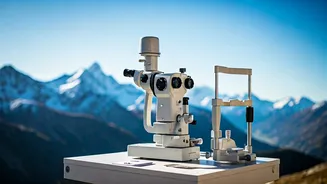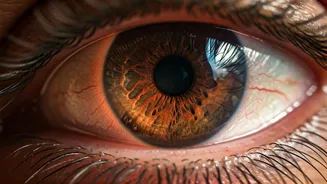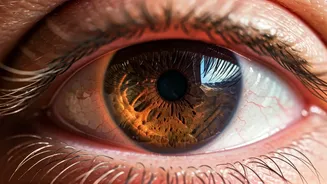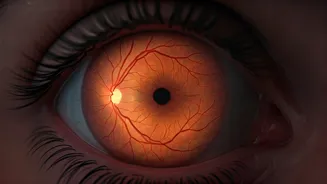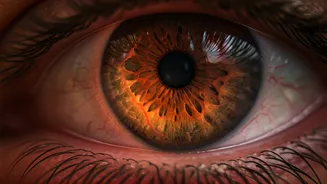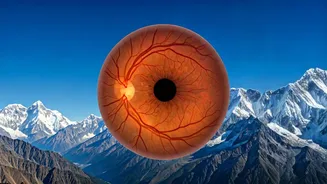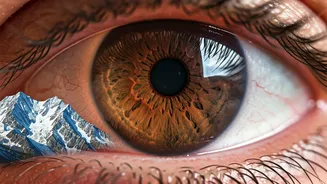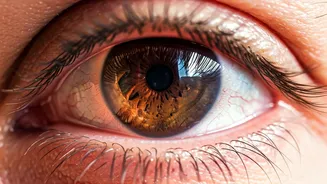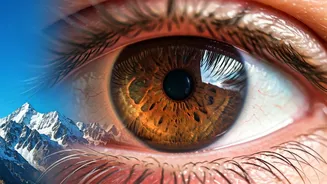Altitude and Eyesight
High altitudes can bring about a unique set of challenges to the human body, with the eyes being particularly vulnerable. The reduced oxygen levels and
lower atmospheric pressure at higher altitudes can lead to several eye-related complications. A prime example is High Altitude Retinopathy (HAR), a condition where the blood vessels in the retina become damaged. This damage can result in blurred vision or even sudden vision loss. The effects can vary from mild to severe, influencing a trekker's ability to navigate the terrain. Understanding these effects is vital for anyone planning to visit high-altitude locations, such as the Himalayas, the Andes, or even certain regions of the Western Ghats. Awareness and preparation are the best strategies to enjoy the panoramic views without compromising eyesight.
What Is HAR?
High Altitude Retinopathy (HAR) is a medical condition triggered by the physiological changes that occur when the body is exposed to lower oxygen pressure. At high altitudes, the blood vessels in the retina can experience stress, leading to leakage or swelling. This affects the clarity of vision. While not everyone is equally susceptible, the risk increases with ascent and duration of exposure. Symptoms can be subtle initially, like slight blurring, but can progress rapidly. In severe cases, it can cause substantial loss of vision. HAR is a significant concern for mountaineers, trekkers, and even individuals who fly at high altitudes in unpressurized cabins. Regular eye check-ups and a proactive approach towards acclimatization, combined with understanding the early signs, can play an essential role in preventing serious outcomes.
Risk Factors and Vulnerability
Certain factors increase a person's vulnerability to HAR. Individuals with pre-existing conditions, such as high blood pressure or diabetes, are at higher risk. The rate of ascent is another critical factor. Rapid ascents do not allow the body adequate time to adjust, increasing the likelihood of eye complications. The altitude itself is a major influence, with risks rising considerably above 10,000 feet. The duration of exposure also matters; the longer one stays at a high altitude, the greater the likelihood of HAR. Age and overall health also contribute. While anyone can be affected, those who are older or have underlying health issues should exercise extra caution. Preparing for the journey with appropriate medical advice can significantly mitigate the dangers associated with high-altitude treks.
Early Warning Signs
Being able to identify the early warning signs of HAR is critical for early intervention. One of the first indications of altitude-related eye problems is blurred vision. This may start subtly and then worsen over time, making it hard to focus on nearby objects or distant landscapes. Headaches are another early warning sign, often coinciding with other symptoms. People may also experience the appearance of spots or floaters in their vision. These are often small specks or shadows that seem to drift across the field of vision. Eye pain or discomfort is also a sign that something is not right. Any of these symptoms should be addressed promptly; ignoring them can accelerate the condition. Regular monitoring and seeking advice from a medical expert should be part of every trekker’s toolkit for enjoying high-altitude adventures.
Pre-Trek Preparations
Before venturing into high-altitude areas, there are several steps that can protect your eyesight. Consulting a doctor, particularly an ophthalmologist, is essential. A baseline eye examination will help identify any pre-existing conditions that could make one more vulnerable to HAR. Gradual acclimatization is very important. This allows your body to gradually adjust to decreasing oxygen levels. If going to a high altitude, start at a lower altitude for a few days before ascending higher. Proper hydration is important, as dehydration can increase susceptibility to high-altitude illnesses. Protective measures, like UV-protective sunglasses, should be worn to protect against the increased UV radiation at higher altitudes. Having travel insurance that covers altitude-related medical issues is a wise precaution, providing peace of mind during your adventure.
Eye Protection During Trek
While trekking, the health of your eyes should be a top priority. Regularly monitor your vision for any changes, such as blurring or floaters. If symptoms occur, descend to a lower altitude immediately. Make sure you stay well-hydrated. The dry air at higher elevations can exacerbate any eye issues. Shield your eyes from sunlight with high-quality UV-protective sunglasses, even on cloudy days. Avoid rubbing your eyes, which can cause irritation or lead to injury. If any eye problems arise, report them immediately. Consider carrying lubricating eye drops or artificial tears to keep your eyes moist, especially in dry conditions. By using these measures, trekkers can enjoy their surroundings while ensuring their vision remains protected.
